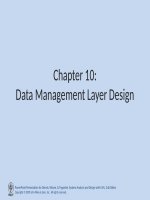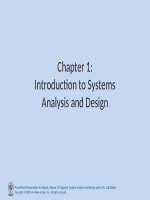Lecture Introduction to systems analysis and design Chapter 13 Whitten, Bentley
Bạn đang xem bản rút gọn của tài liệu. Xem và tải ngay bản đầy đủ của tài liệu tại đây (782.55 KB, 34 trang )
Chapter
Chapter 13
13
Database
Database Design
Design
McGraw-Hill/Irwin
© 2008 The McGraw-Hill Companies, All Rights
Objectives
• Define and give examples of fields, records, files, and
databases.
• Describe modern data architecture of files, operational
databases, data warehouses, personal databases, and work
group databases.
• Compare roles of systems analyst, database administrator,
and data administrator.
• Describe architecture of database management system
• Describe how a relational database implements entities,
attributes, and relationships from a logical data model.
• Transform a logical data model into a physical, relational
database schema.
• Generate SQL to create the database structure in a schema.
13-2
Fields
Field – the smallest unit of meaningful
data to be stored in a database
– the physical implementation of a data attribute
13-3
Fields (continued)
Primary key – a field that uniquely identifies a record.
Secondary key – a field that identifies a single record
or a subset of related records.
Foreign key – a field that points to records in a
different file.
Descriptive field – any nonkey field.
13-4
Records
Record – a collection of fields arranged in
a predetermined format.
– Fixed-length record structures
– Variable-length record structures
Blocking factor – the number of logical
records included in a single read or write
operation (from the computer’s
perspective).
13-5
Files and Tables
File – the set of all occurrences of a given
record structure.
Table – the relational database equivalent
of a file.
13-6
Types of conventional files
and tables
• Master files – Records relatively permanent
though values may change
• Transaction files – Records describe business
events
• Document files – Historical data for review
without overhead of regenerating document
• Archival files – Master and transaction
records that have been deleted
• Table lookup files – Relatively static data that
can be shared to maintain consistency
• Audit files – Special records of updates to
other files
13-7
File and Table Design
• Older file design methods required
analyst to specify precisely how records
should be:
– Sequenced (File organization)
– Accessed (File access)
• Database technology usually
predetermines and/or limits this
– Trained database administrator may be given some
control over organization, storage location, and
access methods for performance tuning.
13-8
Data Architecture
Data architecture – a definition of how:
– Files and databases are to be developed and used
to store data
– The file and/or database technology to be used
– The administrative structure set up to manage the
data resource
13-9
Data Architecture (continued)
Data is stored in some combination of:
– Conventional files
– Operational databases – databases that support
day-to-day operations and transactions for an
information system. Also called transactional
databases.
– Data warehouses – databases that store data
extracted from operational databases.
• To support data mining
– Personal databases
– Work group databases
13-10
A Modern Data Architecture
13-11
Administrators
Data administrator – a database specialist
responsible for data planning, definition,
architecture, and management.
Database administrator – a specialist
responsible for database technology, database
design,construction, security, backup and
recovery, and performance tuning.
– A database administrator will administer one or
more databases
13-12
Database Architecture
Database architecture – the database
technology used to support data architecture
– Including the database engine, database utilities,
CASE tools, and database development tools.
Database management system (DBMS) –
special software used to create, access, control,
and manage a database.
13-13
– The core of the DBMS is its database engine.
– A data definition language (DDL) is used to physically
define tables, fields, and structural relationships.
– A data manipulation language (DML) is used to
create, read, update, and delete records in database
and navigate between records.
Typical DBMS Architecture
13-14
Relational Databases
Relational database – a database that
implements stored data in a series of twodimensional tables that are “related” to one
another via foreign keys.
– The physical data model is called a schema.
– The DDL and DML for a relational database is called
SQL (Structured Query Language).
– Triggers – programs embedded within a database
that are automatically invoked by updates.
– Stored procedures – programs embedded within a
database that can be called from an application
program.
13-15
From Logical Data Model …
13-16
… To Physical Data Model
(Relational Schema)
13-17
User Interface for a
Relational PC DBMS
13-18
What is a Good Data Model?
• A good data model is simple
– The data attributes that describe an entity should
describe only that entity
• A good data model is essentially nonredundant
– Each data attribute exists in at most one entity
(except for foreign keys)
• A good data model should be flexible and
adaptable to future needs
These goals are achieved through database
normalization.
13-19
Database Normalization
(also see Chapter 7)
• A logical entity (or physical table) is in first normal
form if there are no attributes (fields) that can have
more than one value for a single instance (record).
• A logical entity (or physical table) is in second normal
form if it is in first normal form and if the values of all
nonprimary key attributes are dependent on the full
primary key.
• A logical entity (or physical table) is in third normal
form if it is in second normal form and if the values of
all nonprimary key attributes are not dependent on
other nonprimary key attributes.
13-20
Goals of Database Design
• A database should provide for efficient storage,
update, and retrieval of data.
• A database should be reliable—the stored data
should have high integrity and promote user
trust in that data.
• A database should be adaptable and scalable
to new and unforeseen requirements and
applications.
• A database should support the business
requirements of the information system.
13-21
Logical data Model in
Third Normal Form
13-22
Database Schema
• Database schema – a model or
blueprint representing the technical
implementation of the database.
– Also called a physical data model
13-23
A Method for Database Design
13-24
1. Review the logical data model.
2. Create a table for each entity.
3. Create fields for each attribute.
4. Create index for each primary & secondary key.
5. Create index for each subsetting criterion.
6. Designate foreign keys for relationships.
7. Define data types, sizes, null settings, domains,
and defaults for each attribute.
8. Create or combine tables to implement
supertype/subtype structures.
9. Evaluate/specify referential integrity constraints.
Database Integrity
• Key integrity – Every table should have a
primary key.
• Domain integrity – Appropriate controls must
be designed to ensure that no field takes on an
inappropriate value
• Referential integrity – the assurance that a
foreign key value in one table has a matching
primary key value in the related table.
–
–
–
–
13-25
No restriction
Delete: cascade
Delete: restrict
Delete: set null









